|
Cycle manufacturer D. H. & S. in Sedgley
Street, Wolverhampton produced Diamond Cycles, which were named after the
diamond frame design that
owes its origins largely to James Starley's 1885 Rover Safety bicycle.
Diamond cycles were high quality machines,
that were built in reasonable numbers.
Around 1908 the company decided to add motorcycles
to its product range, and was restructured as the
D. F.& M. Engineering Company
Limited. D. F.& M. was an abbreviation for Dorsett, Ford & Mee.
Initially a
few machines, both singles and V-twins, were built using Belgian F.N. engines.
In 1912 a 2¾hp. machine
was launched, featuring a J.A.P. 4-stroke engine, two speed gearbox and
fully enclosed moving parts. It sold for 50 guineas, but sales were
poor.
A new factory called Diamond Works was
soon acquired in Vane Street, Wolverhampton, and
models 'C', 'D', and 'E' were launched.
Production ceased in 1916,
because of wartime Government restrictions.
|

An advert from 1914. |
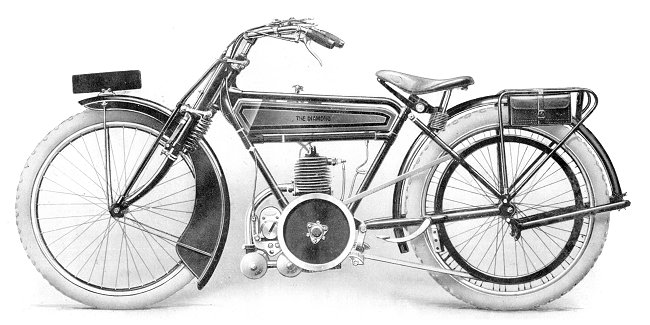
The model 'C' from the 1915 catalogue.
| The model 'C' was a single-speed, belt driven machine,
powered by a 2½hp. Villiers
engine. It sold for £50. It was also available as the model
'D' with a 2-speed gearbox, and a selling price of £60. The
top of the range model 'E' had a 2¾hp. 4-stroke J.A.P.
engine, a 2-speed Enfield gearbox, round-top Dunlop
belt drive, 26inch wheels, Druid forks, 2 leather pannier
bags, and a toolkit, complete with screwdriver, spanners, tyre lever
and oil can. It sold for £66.
The machines were quite popular. |
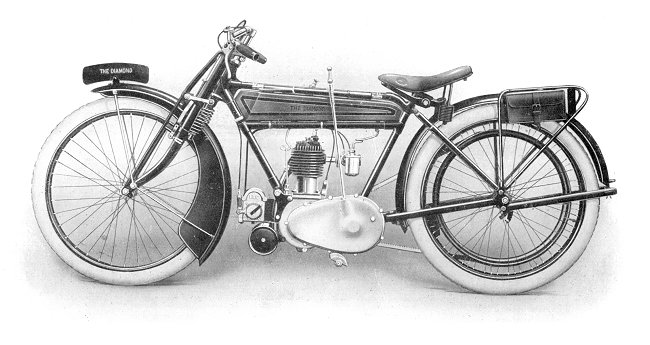
The model 'E' from the 1915 catalogue.
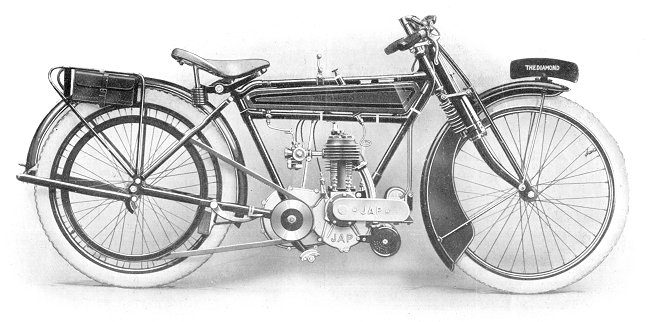
Another view of the model 'E'.

The powerful heel-operated brake and the
conveniently placed adjustable footrests that were a feature of the 1915 models. |
The machines were fitted with a sturdy
frame that had a slanting top rail with a special seat pillar which was
curved to give a low saddle position. This method of construction added
strength to the frame.
The bottom rail was horizontal and had tank
supporting platforms cast on the lugs at either end. The rear down tube
terminated in a specially cast lug, which formed the engine supporting
plates and chain stay attachment.
The chain stay itself was secured to the
lug by a single bolt. |
| An extremely simple yet effective rear
brake was fitted which had very few moving parts. It was attached to the
frame by a specially cast lug on the rear stay and consisted of just the
brake pedal and a brake shoe. It was operated by the rider's heel and was a
great improvement over the commonly used pull rod.
The machines were fitted with Dunlop or
Avon 26inch by 2inch studded tyres and transmission was by an Avon belt. A
large pan-seat saddle was fitted for extra comfort. |
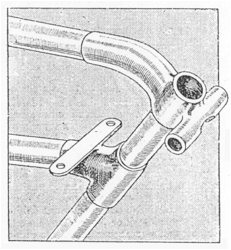
The special seat pillar lug and tank support. |
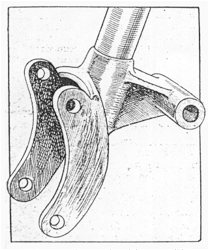 |
The specially cast lug at the
bottom of the rear down tube, which formed the engine supporting
plates, and chain stay attachment. |

An advert from 1920.
| Four new machines were launched in 1922, models 'A',
'F', 'G', and 'H'. The model 'A' had a 350c.c. J.A.P. engine, Druid forks,
clutch, kick start, and was available with a 2 or 3 speed
gearbox. The 2 speed model sold for 66 guineas and the 3 speed model
sold for 70 guineas. The model 'F' had a 293c.c. J.A.P. engine, Druid forks,
clutch, kick start, and was also available with a 2 or 3
speed gearbox. The 2 speed model sold for 58 guineas and the 3 speed
model sold for 62 guineas. The 'Super Sports Model G' had a 350c.c. J.A.P. engine, 3 speed Sturmey Archer gearbox, Druid forks, Hans Renold
or Coventry roller chain drive, and sold for 80 guineas.
The 'Super Sports Model H' had a 250c.c. J.A.P. engine, 2
or 3 speed Sturmey Archer gearbox, Druid forks, and a Hans Renold
or Coventry roller chain drive. The 2-speed model sold for 75 guineas,
and the 3-speed model sold for 79 guineas. |
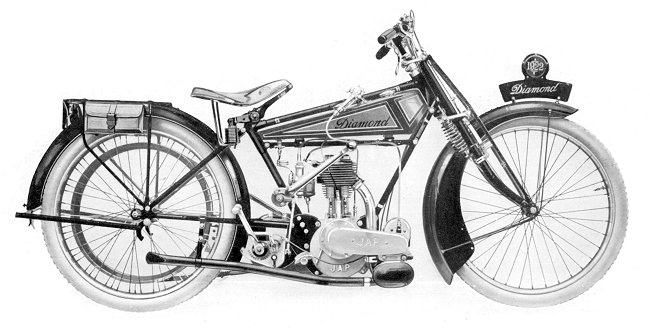
The model 'A' from the 1922 catalogue.
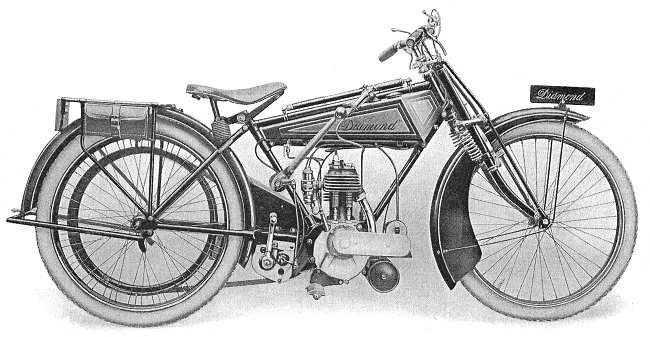
The model 'F' from the 1922 catalogue.

The 'Super Sports Model G' from the 1922 catalogue.

A Diamond motorcycle photographed in October 1923.
Courtesy of David Clare.
 |
|
Another view of the same motorcycle with its proud
owner, photographed in October 1922. Courtesy of David
Clare. |
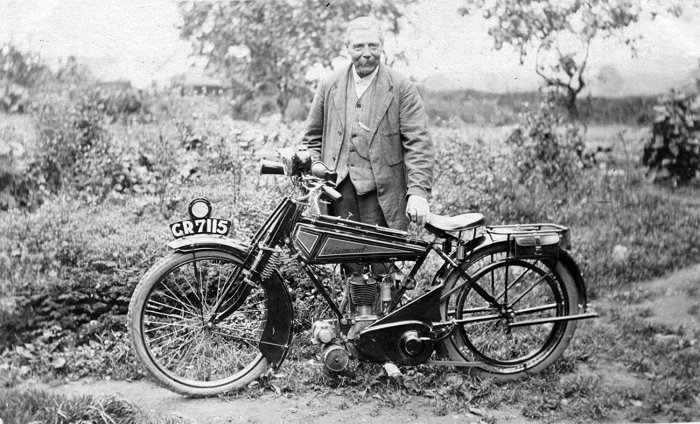 |
|
A third and final view of the motorcycle, also from
October 1922, with the owner's father. Courtesy of
David Clare. |

The 'Super Sports Model H' from the 1922 catalogue.

The lightweight Diamond duplex
frame. Patent number 155882/19. From the 1922 catalogue.
| In the early 1920's the company had numerous successes in
reliability trials and races, and won 65 awards in trials alone,
including a gold medal in the Paris-Nice Trial, a gold medal in
the A.C.U. Six Days Trial, the highest award in the Victory Cup
Trial. In 1921, Diamond won the Flying Five Miles and the Standing 10 Miles
at Brooklands, and Kay Don won the special 1921 Brooklands 250c.c. speed
trial, on a Diamond machine, at 69.59m.p.h. In 1924, Diamond
rider J. A. Forsythe achieved second place in the 250c.c. class
in the Ulster Grand Prix. |
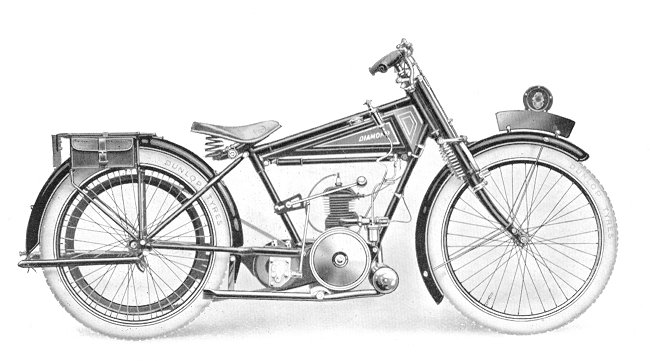
The 1½hp.
ultra lightweight model from the 1923 catalogue.
| The 1923, 1½hp. ultra lightweight model had a Villiers
engine, 2 speed Sturmey Archer gearbox, A.M.A.C. carburettor, Druid
forks, Dunlop tyres, and sold for £35. |
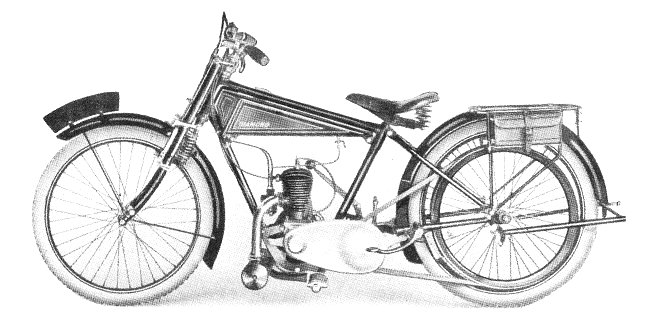
Another view of the 1½hp.
model.
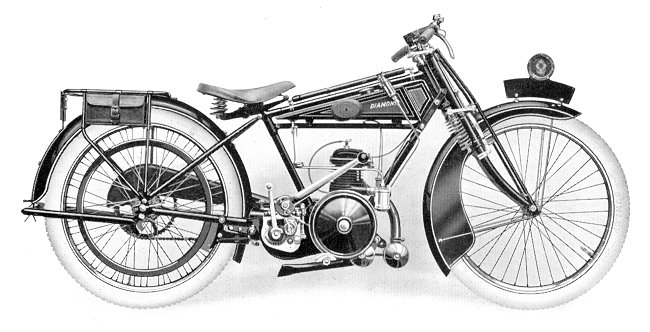
The 2½hp.
ultra lightweight model from the 1923 catalogue.
| The 1923, 2½hp. ultra lightweight model had a Villiers
engine, 2 speed Sturmey Archer gearbox, clutch and kickstart, chain
drive, A.M.A.C. carburettor, Druid forks, Dunlop tyres, and sold for
£52.10s. It was also available with a 3½hp. Villiers
engine, 3 speed gearbox, shock absorber, and sold for £60.
Sales were not good. By 1926 only two models were on
offer, and production ceased in 1928. The story didn't end there however,
because Walter Vincent Ford, Diamond's managing director and designer,
founded Diamond Motors in St. James Square, Wolverhampton, and motorcycle
production restarted in 1930.
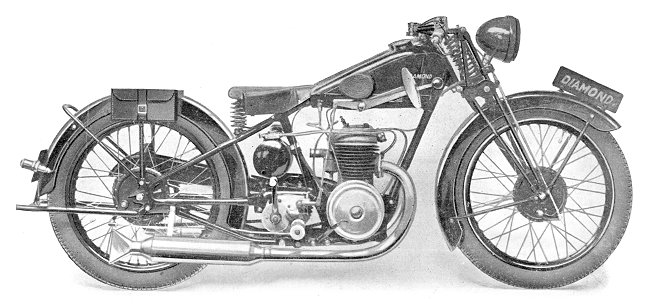
The 'Diamond' from the 1930 catalogue.
The 1930 model was powered by a 247c.c., 2-stroke Villiers engine, and included a 3-speed Burman
gearbox, a 3-plate
clutch, Druid sports forks, and was priced at 35 guineas. It was also
available with electric lighting for an extra £2.12s, and a dynamo
charging set at an extra £5. The machine was fitted with Dunlop 25
inch by 3inch tyres and 6inch internal expanding brakes.
Diamond also produced the 1930 motorcycle
in kit-form, for export. The export kits were sold minus the engine, which
would be ordered separately from Villiers. Local agents could assemble the
machine, and put their own name on the petrol tank.
|
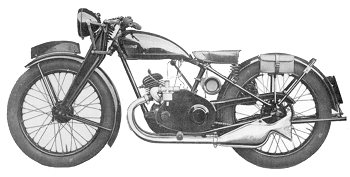
One of the last machines, the 148c.c. model
from 1933. |
Sales were poor and
production finally ceased in 1933.
From the early 1920s until 1931 Diamond machines competed in
the Isle of Man T.T. In the 1924 Ultra Lightweight race, Alec
Bennett finished in 9th place riding his 175c.c. Villiers
powered Diamond.
Diamond's greatest T.T. success was in the 1926 Ultra
Lightweight race when Syd Gleeve finished in 7th place. |
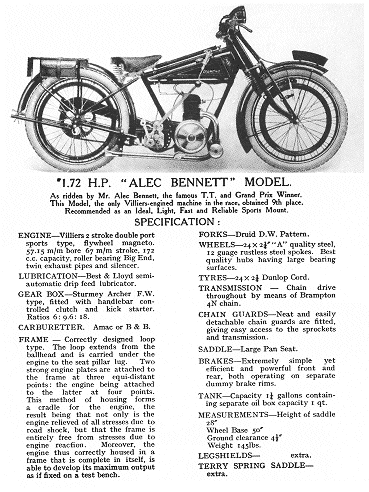
The Diamond 'Alec Bennett' model.
| Although motorcycle production ended in 1933, the company
continued to exist for many years, manufacturing sidecars,
trailer and caravan chassis, and electric trucks. In October
1931 motorcycle manufacturer A.J.S. went into voluntary
liquidation. At the time they made sidecars using the
'Graiseley' name.
Walter Vincent Ford was approached by Alec Holder, who had
worked for Clyno as a draughtsman, and Harold Nock, who later
acquired D.M.W. with the idea of acquiring the A.J.S. sidecar
business in order to manufacture sidecars and supply them to
existing A.J.S. customers. As a result, Diamond Motors purchased
the A.J.S. sidecar business, together with the 'Graiseley' trade
mark for £475, and continued to produce 'Graiseley' sidecars for
ex-A.J.S. customers, including Swallow.
In 1935 the business moved to the old Villiers foundry
building in Upper Villiers Street, Wolverhampton, and extended
the product range to include the 'Graiseley' pedestrian
controlled electric truck. It initially proved popular as a
cheap milk delivery vehicle, but then found uses in hospitals,
factories, and warehouses, where its fumeless, noiseless, and
economical operation, made it an ideal form of transport. |
| A 'Graiseley' truck in operation. |
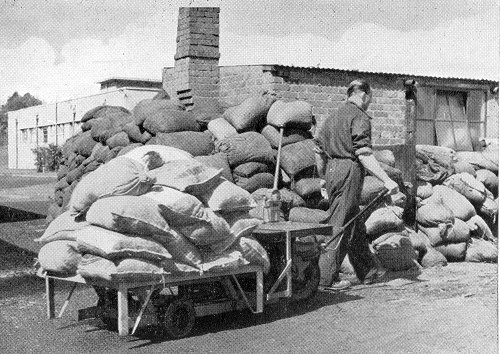 |

The 'Graiseley' electric milk float.
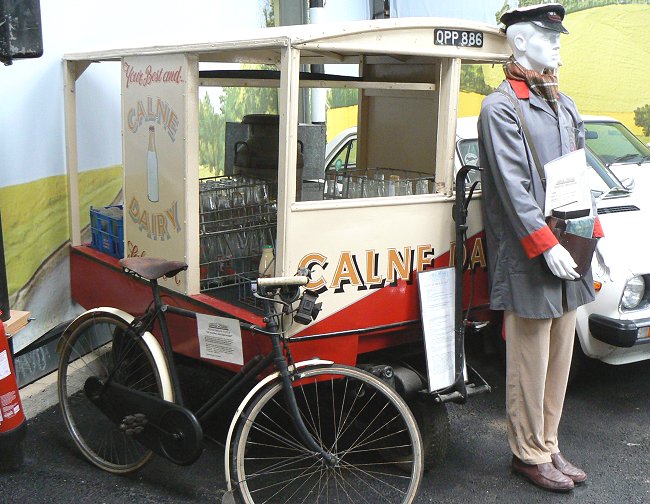
The 'Graiseley' milk float that is on display
at the Atwell-Wilson Motor Museum, Calne, Wiltshire. Courtesy of
Brian Shaw. |
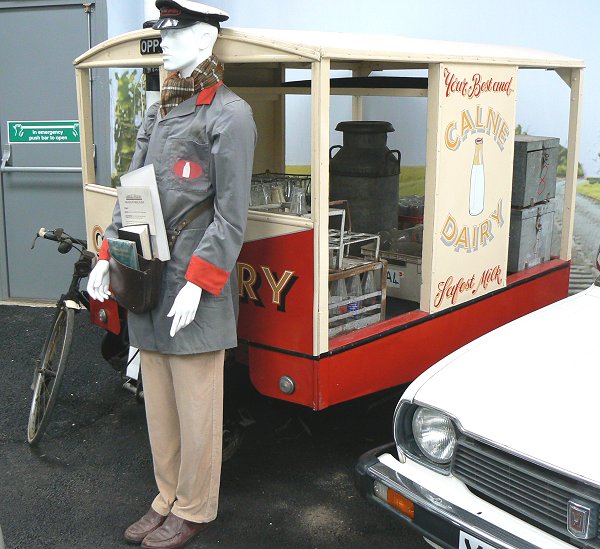
Another view of the Atwell-Wilson Motor
Museum's 'Graiseley' milk float. Courtesy of Brian Shaw. |
| During World War 2 the company produced gun carriages and
electric trucks for the War Department, and also did machining
for the Air Ministry. After the war production of electric
trucks resumed. Production of 'Graiseley' products continued
until around 1960 when the company went into liquidation. |
|